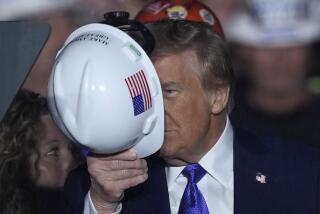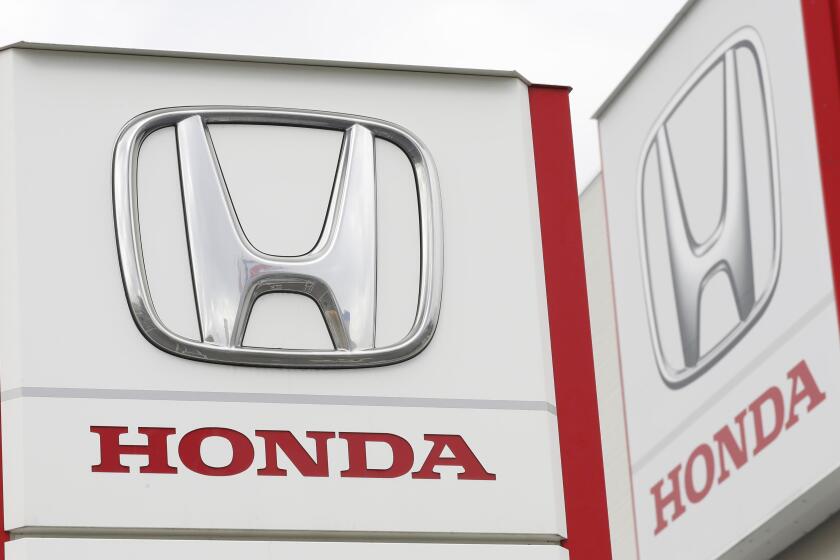Trump’s presidency may be hurting his L.A.-area golf course
At President Trump’s golf club in Rancho Palos Verdes, there is a driving range on a cliff, with a stunning view of the blue Pacific. There’s room for 24 golfers.
But, on a recent afternoon, there was only one.
And he was playing with a guilty conscience.
“I feel like I’m cheating on my wife,” said Richard Sullivan, a 59-year-old doctor.
His wife is a fierce opponent of the president’s politics. She’d recently caught Sullivan with a freebie water bottle bearing the Trump logo. “Don’t ever go to Trump again,” she ordered. Sullivan had stopped playing full $300 rounds of golf there, but he sneaked back to the range.
He often found it empty. “It’s just dead all the time,” Sullivan said.
For two years, Trump has been running a first-of-its-kind American experiment: Can one man be the face of a polarizing political movement and a successful hospitality business?
Certainly, some parts of Trump’s empire stand to benefit from his new power. His Mar-a-Lago Club serves as a “winter White House,” where paying guests might watch a national security meeting unfold over dinner. Trump tweeted repeatedly from his Bedminster, N.J., course last weekend promoting the U.S. Women’s Open tournament that was happening there.
But in Los Angeles County, the experiment doesn’t seem to be going well.
Since Trump entered the presidential race in June 2015, revenue from greens fees at the Trump National Golf Club in Rancho Palos Verdes has dropped 13%, according to figures from the city government.
Charity golf tournaments, another core piece of the club’s business, have moved away: ESPN relocated its celebrity tournament. The L.A. Galaxy soccer team withdrew. The L.A. Unified School District also moved, forfeiting a $7,500 deposit it had already paid Trump’s course.
Hollywood, another source of revenue for the club, has largely stopped coming to film TV shows and movies, according to city permit records.
The club’s wedding business seems to have been affected as well. Couples used to hold big outdoor ceremonies at a city park across the street, then return to Trump National for a reception.
Nobody has done that since November, according to city records.
The troubles at the L.A.-area club mirror those that have been reported at some other Trump properties. Together, they illustrate an unexpected side effect of the presidency: In some cases, it has proved a challenge to sell the president’s brand without offering proximity to the presidency itself.
In Manhattan, the banquet business is down at the Trump SoHo hotel, according to radio station WNYC. In the Bronx, both golf revenue and banquet revenue are down at Trump’s golf course, according to records released by New York City.
The Washington Post reached out to four officials at the Trump Organization with questions about the California course. Just one responded.
“David — please stop reaching out to me. Thank you,” Eric Trump, the president’s son, wrote in an email.
The challenges facing Trump’s course can be seen in a series of public records provided by the city of Rancho Palos Verdes and Los Angeles County, which collect taxes from the course and issue permits for some activities there.
Together, they offer a portrait of a business that seems to be struggling under the weight of its name.
Trump’s course is set on Pacific cliffs, about 30 miles south of downtown Los Angeles. The area is heavily Democratic, represented in Congress by a fierce Trump critic, Democratic Rep. Ted Lieu. Since Trump won the election, the club has been the scene of small acts of defiance — the Hollywood Reporter reported that it saw someone urinate on the sign — and a large, expensive act of vandalism.
In March, Trump’s course was vandalized by people calling themselves environmental activists, who carved the words “No More Tigers. No More Woods” into the turf at the fifth green. The crime, which has not been solved, caused about $20,000 in damage, according to the Sheriff’s Department.
Trump says he spent $27 million to buy this course and $250 million-plus to repair it and reopen it in 2006. Under the previous owner, the 18th fairway had fallen into the ocean. “The most expensive golf course ever built,” Trump has called it. Unlike most other Trump clubs, it is open to the public, instead of being limited to dues-paying members.
The course has some disadvantages that predate Trump’s political rise. It is maddeningly difficult, with skinny fairways and shot-bending wind gusts off the ocean. And it costs up to $300 a player. A county course nearby charges $45 for a round.
“Most people don’t play it regularly. It’s a one-off kind of golf experience,” for tourists or golfers looking for a splurge, said Gene Krekorian, a California golf-course appraiser who has assessed this course. “It’s a spectacular facility, but it’s way overpriced.”
The Trump course had found other ways to make money.
Hollywood, for instance, didn’t care how the course played — just how it looked. When the ABC television show “Modern Family” needed a location for a scene where a stodgy, luxurious golf club would host a gay wedding, Trump National played the part.
The CBS TV drama “Criminal Minds” transformed the Trump clubhouse into a faux U.S. Embassy in the Caribbean. In the film “Horrible Bosses 2,” a group of boneheads argued next to a putting green. In a Geico insurance commercial, a caveman crashed a golf cart. Even the TV commercials paid well — about $20,000 for a one-day ad shoot, according to a producer who filmed there.
But soon after, Trump entered the presidential race, with fiery populist rhetoric and speeches blasting immigrants in the country illegally. That played poorly with the customers he had cultivated for this California course: Hollywood, athletes, rich Californians and young people planning weddings.
Within a month, ESPN had canceled. So had the school district, whose students are 74% Latino. “There was absolutely no reason to host our largest fundraiser at a Trump facility,” an official said. The L.A. Galaxy said Trump’s remarks “do not reflect our club’s values of respect and diversity.”
“It was a great place. And our golf tournaments haven’t been the same since then,” said Andy Bales, a Christian minister who leads the Union Rescue Mission on Los Angeles’ skid row. His group had held golf tournaments at the Trump club every year since 2011. In 2016, the group went elsewhere. “It just became too much of a controversy for our donors — some of our donors — and our team members to continue to utilize that property.”
In all, 12 tournaments or charity events stopped returning to the Trump course in 2015 or 2016, according to a Post survey of groups that had staged events there.
Not all cited politics in their decisions. But all of them were gone, depriving the Trump club of at least $250,000 total in rental fees and catering costs, according to interviews and a review of IRS charity records.
In the same period, city-issued permits for filming at Trump National also showed a decline. There were 28 issued in the two years before Trump entered the race. In the two years afterward, there were only 11.
“We got a lot of flak for shooting there. Really, you know, ‘What are you doing?’ There are a lot of Democrats in my business,” said Kent Feuerring, a producer who helped arrange one of those shoots, a commercial for Samsung TVs shot at the course in February 2016.
In the months since Trump took office, only two companies have obtained permits to shoot at the course. They were not big Hollywood productions.
One was an ad for a Japanese golf-club company, aimed at the Japanese market. The other was a Munsingwear ad, featuring “exterior action and dialogue with golfers,” according to a city permit. It’s not clear what was being advertised. A spokeswoman for the company did not respond to questions. Munsingwear’s products appear to include golf clothes and a line of men’s underwear.
Another barometer of success: The permits issued by the city for outdoor weddings at an oceanfront park next to the course, where the couples returned to Trump National for their reception.
These are only a subset of all weddings held at the club — couples often use the city park for larger weddings. Before Trump got into politics, the club averaged 17 such weddings a year.
When he was a candidate, the figure fell to 11 in 2016.
So far this year, it’s zero. None have been issued since November.
Even getting people to come play golf appears to be difficult these days.
On the same day Sullivan was playing alone on the Trump driving range, 30-year-old Sherry Park of West Hollywood was practicing putts at Los Verdes, the Trump course’s crosstown rival.
“I’m a flaming liberal, so I can’t go there,” Park said. Trump’s course, she added, is “beautiful.” “If he weren’t president, I would definitely go.”
The Trump course’s revenue from greens fees and golf-cart rentals fell about 12%, from about $3.3 million before Trump entered the race to about $2.9 million in each of the two years since. Those figures can be calculated from the money that the city of Rancho Palos Verdes gets from its “golf tax,” a 10% levy on greens fees and cart rentals.
During the same period, golf courses around Southern California experienced a slight upswing in business, said Craig Kessler of the Southern California Golf Assn., relying on figures provided by public golf courses across the region. So the Trump course’s decline doesn’t seem to match a broader trend.
“It’s underperformed the market since 2015,” Kessler said. “Just at the time when the rest of the industry was starting to see some upticks ... it seems to have gone into a decline.”
On a recent summer Saturday, it was easy to spot signs of the Trump course’s troubles. Just before 7 a.m., for instance, the course’s online schedule showed 40 of the day’s 65 tee times were still available.
That night, the contrast was even more obvious.
At Los Verdes, the clubhouse bustled with preparations for a wedding reception. At Terranea Resort, another nearby club, there was another wedding reception, a live band and a mentalist performing for a crowd. Cars circled the parking lot, looking for spaces.
At the Trump club, the parking lot was a quarter full.
The ballrooms were empty and quiet. No weddings.
At the course’s upscale restaurant, with $56 steaks, a keyboardist played mood music for a dinner crowd of two.
Nearby, in the half-full Golfers’ Lounge, was 60-year-old Steve Patrick, a tavern owner from nearby working-class San Pedro.
He was a Trump supporter and a Trump customer, in a place where both are rare.
“He’s the most persecuted president that’s ever lived in the history of the United States,” Patrick said.
Fahrenthold and Kuznia write for the Washington Post. The Post’s Alice Crites and Steven Rich contributed to this report.
More to Read
Inside the business of entertainment
The Wide Shot brings you news, analysis and insights on everything from streaming wars to production — and what it all means for the future.
You may occasionally receive promotional content from the Los Angeles Times.










